Book contents
- Frontmatter
- Contents
- PREFACE
- SECTION I INTRODUCTION TO MULTIMEDIA LEARNING
- 1 The Promise of Multimedia Learning
- 2 The Science of Instruction: Determining What Works in Multimedia Learning
- 3 The Science of Learning: Determining How Multimedia Learning Works
- SECTION II PRINCIPLES FOR REDUCING EXTRANEOUS PROCESSING IN MULTIMEDIA LEARNING
- SECTION III Principles for Managing Essential Processing in Multimedia Learning
- SECTION IV PRINCIPLES FOR FOSTERING GENERATIVE PROCESSING IN MULTIMEDIA LEARNING
- SECTION V CONCLUSION
- REFERENCES
- AUTHOR INDEX
- SUBJECT INDEX
- References
1 - The Promise of Multimedia Learning
- Frontmatter
- Contents
- PREFACE
- SECTION I INTRODUCTION TO MULTIMEDIA LEARNING
- 1 The Promise of Multimedia Learning
- 2 The Science of Instruction: Determining What Works in Multimedia Learning
- 3 The Science of Learning: Determining How Multimedia Learning Works
- SECTION II PRINCIPLES FOR REDUCING EXTRANEOUS PROCESSING IN MULTIMEDIA LEARNING
- SECTION III Principles for Managing Essential Processing in Multimedia Learning
- SECTION IV PRINCIPLES FOR FOSTERING GENERATIVE PROCESSING IN MULTIMEDIA LEARNING
- SECTION V CONCLUSION
- REFERENCES
- AUTHOR INDEX
- SUBJECT INDEX
- References
Summary
Multimedia learning refers to learning from words and pictures. Multimedia instruction refers to the presentation of material using both words and pictures, with the intention of promoting learning. The case for multimedia learning rests on the premise that learners can better understand an explanation when it is presented in words and pictures than when it is presented in words alone. Multimedia messages can be based on the delivery media (e.g., amplified speaker and computer screen), presentation mode (e.g., words and pictures), or sensory modalities (e.g., auditory and visual). The design of multimedia instructional messages can be based on a technology-centered approach that focuses on the capabilities of advanced technologies or on a learner-centered approach that focuses on the nature of the human cognitive system. Multimedia learning may be viewed as response strengthening (in which multimedia environments are used as drill-and-practice systems), information acquisition (in which multimedia messages serve as information delivery vehicles), or as knowledge construction (in which multimedia messages include aids to sense-making). Three possible learning outcomes are no learning (as indicated by poor retention and poor transfer performance), rote learning (as indicated by good retention and poor transfer performance), and meaningful learning (as indicated by good retention and good transfer performance). Meaningful learning outcomes depend on the cognitive activity of the learner during learning rather than on the learner's behavioral activity during learning.
Information
- Type
- Chapter
- Information
- Multimedia Learning , pp. 3 - 27Publisher: Cambridge University PressPrint publication year: 2009
References
Accessibility standard: Unknown
Why this information is here
This section outlines the accessibility features of this content - including support for screen readers, full keyboard navigation and high-contrast display options. This may not be relevant for you.Accessibility Information
- 7
- Cited by
